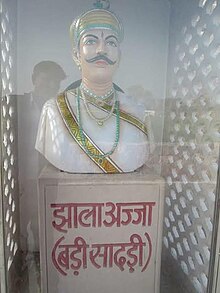Ajja Jhala
| Ajja Jhala | |
|---|---|
| Maharaj Rana of Jhalavad Ajmerpati of Ajmer RajRana of Badi-Sadri Raj Jhalleshwar | |
 Statue of Jhalleshwar Raj Jhala Ajja in Bari-Sadri | |
| Reign | 1499 |
| Coronation | 1499 |
| Predecessor | Maharaj Rana Raidharji Vogohoji Jhala |
| Successor | Maharaj Rana Ranoji Jhala |
| Reign | 1506-1527 |
| Coronation | 1506 |
| Predecessor | Post established |
| Successor | RajRana Siha Jhala |
| Reign | 1506-1527 |
| Coronation | 1506 |
| Predecessor | Post established |
| Born | 1479 |
| Died | 17 March 1527 Khanwa |
| Issue | RajRana Siha Jhala RajRana Asaji Jhala |
| Dynasty | Jhala Dynasty |
| Father | Maharaj Rana Raidhar Jhala |
| Mother | Surajkunvarba of idar |
| Religion | Hinduism |
Raj Jhalleshvar Maharaj Rana Ajay Singh Jhala,[1] known as Ajja Jhala or Ajoji, was the 25th ruler of Jhalavad (Dhrangadhra). He was an important vassal of Mewar during Rana Sanga's period. He played a crucial role in the battles of Bayana, Dholpur and Khanwa. He wore the royal insignia of Rana Sanga and was reputed to have saved Sanga's life in battle of Khanwa.[2]: 455 [3]
Life[edit]
Ajoji was born into the royal family of Jhalas, the oldest son of Raidharji Jhala. Ajoji was crowned as the 25th Ruler of Jhalavad in the year 1499. His stepbrother Ranoji and stepmother purportedly asked Raidharji to depose Ajoji and make Ranoji the ruler of Jhalavad in his place. In deference to his father's wishes, Ajoji gave the throne to Ranoji in the year 1500 and left Jhalavad. In the year 1506 he reached Mewar during the reign of Rana Raimal, who was his sister's husband. Rana Raimal gave him multiple Jagirs including Ajmer, Badi Sadri, Jhadol and Gogunda, with the title Raj Rana as a vassal king.
Badi-Sadri[edit]
In the 15th century, the Kingdom of Mewar was divided into 16 first grade thikanas or districts. Badi Sadri was one of the 16 Rajwadas, along with Delwara and Gogunda.[4] Badi Sadri has been ruled by Jhala Rajputs from the 15th century onwards. The ancestor of the Jhala family was Raj Sahib Raidharji Vogohoji of Dhrangadhara (Halvad), descendant of Harpal Makwana. During the reign of Maharana Raimal (1473–1509), Ajoji (Ajja Singh Jhala) the deposed son of Raj Sahib Raidharji, along with his brother Sajoji (Sajja Singh Jhala) came to Mewar. Jhalas performed meritorious service in Mewar. Later the Maharana granted the Jagir of Delwara to Kunwar Sajja and that of Ajmer and Bari Sadri to Kunwar Ajja Singh and were granted the title of Raj Rana.[5]
Sacrifice[edit]

Ajja fought alongside Maharana Sangram Singh I (1509–1527) against Babur in 1527 at the Battle of Khanwa.[7][8] When Maharana Sangram Singh (Rana Sanga) was wounded on the battlefield, Rana Sanga looked similar to Ajoji as he was Rana Sanga's maternal uncle. Ajja donned the Maharana's tunic, which kept the Mewar army together but proved fatal for Raj Rana Ajja, who died as a hero in the battle.
As many as 7 generations of the Jhala family had been sacrificing their lives for the Maharanas of Mewar.

• 1st Raj Rana, Ajja Jhala died in battle of Khanwa 1527.
• 2nd Raj Rana, Ajja's son Sihaji Jhala died in the 2nd siege of chittorgarh 1535.
• 3rd Raj Rana, Sihaji's 1st son Asaji Jhala died in battle of Mavli 1540.
• 4th Raj Rana, Sihaji's 2nd son Surtan Singh Jhala died in the 3rd Siege of chittorgarh 1568.
• 5th Raj Rana, Surtan's son Man Singh Jhala Sacrificed his life in Haldighati while protecting Maharana Pratap in 1576.[9]
• 6th Raj Rana, Jhala Man's son Dedaji Jhala died in battle of Ranakpur 1609.
• 7th Raj Rana, Dedaji's son Hardas Jhala died in the battle of hurda 1622.
In honour to the Sacrifices of Jhalas, they were given 1st position in Udaipur Durbar and only the Raj Rana Jhalas were given rights to wear the royal insignia of Maharanas of Mewar.[10]
References[edit]
- ^ Jhala, Angma; Jhala, Jayasinhji (2017-04-24). Genealogy, Archive, Image: Interpreting Dynastic History in Western India, c.1090-2016. Walter de Gruyter GmbH & Co KG. ISBN 978-3-11-053945-5.
- ^ A History of Rajasthan. Rupa & Company. 2006. ISBN 978-81-291-0890-6.
- ^ Bhardwaj, Kanwal Kishore (2000). Hemu: Napoleon of Medieval India. Mittal Publications. ISBN 978-81-7099-663-7.
- ^ Girase, Jaypalsingh (2020-08-02). Rashtragaurav Maharana Pratapsingh: Ek Aprajit Yoddha (in Hindi). Notion Press. ISBN 978-1-64919-952-2.
- ^ Ulian, Eva (2010-03-23). Rajput. WestBow Press. ISBN 978-1-4497-0061-4.
- ^ Jhala, Angma; Jhala, Jayasinhji (2017-04-24). Genealogy, Archive, Image: Interpreting Dynastic History in Western India, c.1090-2016. Walter de Gruyter GmbH & Co KG. ISBN 978-3-11-053945-5.
- ^ Sinh, Karuna; Sinh, Randhir (2020-02-04). The Flute and the Sword: The Story of Meera and Jaimal and the Rise and Fall of Merta. Vij Books India Pvt Ltd. ISBN 978-81-942618-4-1.
- ^ Sinh, Karuna; Sinh, Randhir (2020-02-04). The Flute and the Sword: The Story of Meera and Jaimal and the Rise and Fall of Merta. Vij Books India Pvt Ltd. ISBN 978-81-942618-4-1.
- ^ Singh, Pratap Narayan. The Helios of the Aravalis (Novel). Diamond Pocket Books Pvt Ltd. ISBN 978-93-5684-631-9.
- ^ Singh, Pratap Narayan. The Helios of the Aravalis (Novel). Diamond Pocket Books Pvt Ltd. ISBN 978-93-5684-631-9.
